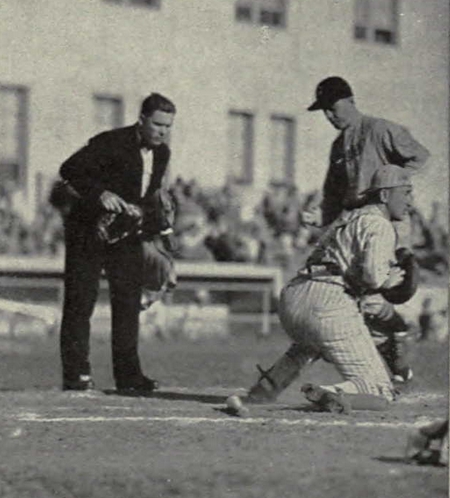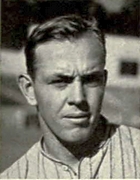Jim Grilk
| Date and Place of Birth: | September 21, 1914 Manila, Philippine Islands |
| Date and Place of Death: | July 16, 1942 nr. Woodland, Sacramento, CA |
| Baseball Experience: | Minor League |
| Position: | Catcher/First Base |
| Rank: | Civilian Instructor |
| Military Unit: | Civilian Athletic Director at Sacramento Army Air Depot |
| Area Served: | United States |
Jim Grilk was a civilian, using his baseball skills to help the military sports program and make the team at Sacramento Army Air Base one of the best in the state.
James M. Grilk was born in Manila in the Philippine Islands, and was
raised in San Francisco, California. He attended the University of
California at Berkeley, where he was a standout first baseman for the
Golden Bears with a conference-leading .377 batting average in 1935.
Grilk attracted offers from the Yankees and Indians but it was the St.
Louis Cardinals that got him to sign in May 1935. That summer he joined
the Bloomington Bloomers of the Class B Three-I League, where he got off
to a sensational start, batting .407 after 12 games. Sixty-three games
into the season, he had a .306 batting average, seven home runs and 35
RBIs, and finished the year with the Huntington Red Birds of the Class C
Middle-Atlantic League, where he batted .315 in 22 games.
In 1936, Grilk joined the Sacramento Solons of the Class AA Pacific
Coast League. Opening Day was a memorable one for the first baseman
because he was involved in the Pacific Coast League’s first Opening Day
triple play. With runners on first and second in the first inning of the
game against Portland, Sid Stringfellow, the Solons shortstop, caught a
line drive hit by Portland’s Bill Sweeney, and then tossed the ball to
Frank Morehouse at second, who relayed the ball to Grilk at first to
complete the triple play. Another unique feature of the play was that it
was the first Pacific Coast League fielding chance for all three
infielders.
Grilk, who was also given a trial as a catcher by manager Bill Killefer,
and played 31 games at that position, played 158 games with the Solons
in 1936, for a .258 batting average and 10 home runs. He was acquired by
the Toronto Maple Leafs of the Class AA International League for 1937,
but refused to report and found himself playing Class B baseball with
the Asheville Tourists of the Piedmont League. Grilk proved to be one of
the best hitters in the league and batted .320 in 136 games with 43
doubles, 25 home runs and 120 RBIs. The Cardinals’ organization sent the
23-year-old to the Columbus Red Birds of the Class AA American
Association for 1938, where he split time as a catcher and first
baseman, and batted an uncharacteristic .234 in 50 games. He finished
the season back with Asheville and batted only .245 in 45 games.
Despite his weak year at the plate in 1938, Grilk was proving himself to
be a useful defensive catcher and he returned to California and the
Solons in 1939, playing 98 games, and splitting catching duties with
Bruce Ogrodowski. Grilk enjoyed a career-year in 1940, playing 125 games
as Sacramento’s starting catcher, and batting .299 with 48 RBIs. The
following year, just as he seemed to be a permanent fixture in the
Pacific Coast League, he broke a finger which did not mend properly. His
batting average plummeted to .219 in 18 games and the Solons loaned him
to the New Orleans Pelicans of the Class A1 Southern Association, where
he batted .231 in 39 games.
By the spring of 1942, the United States was at war, and Grilk was on
loan again, but this time as a civilian athletic director at the
Sacramento Army Air Depot, where he was player/manager with the depot
baseball team. On Monday, July 13, 1942, Grilk (who had just applied for
a commission with the Army Air Force) and Lieutenant John Corcoran were
driving to Sacramento after a day’s fishing. At around 4:30 P.M., 20
miles northwest of Sacramento, near Woodland, with Corcoran at the
wheel, they collided with an oncoming vehicle. Grilk suffered multiple
injuries including a fractured skull that rendered him unconscious. He
was taken to the nearby Yolo Hospital for treatment. Corcoran was also
treated for cuts and a possible skull fracture. The occupants of the
other vehicle, Charles Frields and his 15-year-old son Edward, had been
en route to Knights Landing to look for work. Charles suffered minor
injuries while Edward suffered a fractured left arm. Grilk was still
unconscious when he was moved to Sutter Hospital in Sacramento for
further treatment. He died, without regaining consciousness, three days
after the accident, on Thursday, July 16, 1942.
Grilk was buried at East Lawn Memorial Park, Sacramento, on July 18. He
was survived by his wife, Elizabeth, a sister, Dorothy, a brother,
Arthur, and his mother, Elizabeth.

Jim Grilk scores the winning run for the University of California at Berkeley, to break a 5-5 tie in the tenth inning against Stanford
|
Year |
Team |
League |
Class |
G |
AB |
R |
H |
2B |
3B |
HR |
RBI |
AVG |
| 1935 |
Bloomington |
Three-I | B | 63 | 232 | 41 | 71 | 17 | 2 | 7 | 35 | .306 |
| 1935 | Huntington | Mid-Atlantic | C | 22 | 89 | 12 | 28 | 2 | 0 | 3 | 13 | .315 |
| 1936 | Sacramento | Pacific Coast | AA | 158 | 592 | 65 | 153 | 32 | 6 | 10 | 76 | .258 |
| 1937 |
Asheville |
Piedmont | B | 136 | 544 | 99 | 174 | 43 | 5 | 25 | 120 | .320 |
| 1938 | Columbus | American Assoc. | AA | 50 | 137 | 14 | 32 | 4 | 5 | 2 | 16 | .234 |
| 1938 |
Asheville |
Piedmont | B | 45 | 151 | 13 | 37 | 8 | 1 | 0 | 23 | .245 |
| 1939 | Sacramento | Pacific Coast | AA | 98 | 273 | 13 | 65 | 13 | 1 | 3 | 33 | .238 |
| 1940 | Sacramento | Pacific Coast | AA | 125 | 331 | 27 | 99 | 16 | 1 | 6 | 48 | .299 |
| 1941 | Sacramento | Pacific Coast | AA | 18 | 34 | 3 | 14 | 0 | 0 | 1 | 6 | .219 |
| 1941 | New Orleans | Southern Assoc. | A1 | 39 | 91 | 8 | 21 | 2 | 0 | 1 | 9 | .231 |
Thanks to Astrid van Erp for help with photos for this biography
Date Added January 30, 2011. Updated July 29, 2017
Baseball's Greatest Sacrifice is associated with Baseball Almanac
Baseball's Greatest Sacrifice is proud to be sponsored by


